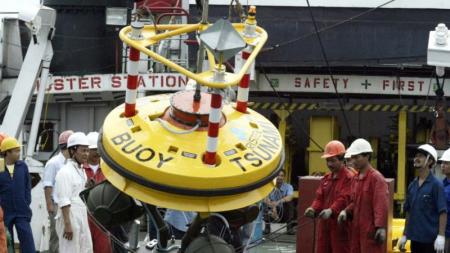
This tsunami buoy undergoing inspection in Indonesia is part of the Indian Ocean tsunami warning system introduced after the 2004 tsunami
By Andy McElroy
ULAANBAATAR, 4 July 2018 – Vulnerable people are an untapped resource of wisdom, capacity and commitment to tsunami, and overall disaster resilience.
This was the resounding conclusion of a Special Session ‘Leave no one behind: Promoting inclusion in tsunami risk management’ at the Asian Ministerial Conference on Disaster Risk Reduction today.
Chair of the session, Mr. Phillip Gibson, Special Envoy for Disaster Risk Management, New Zealand, said that different people have different capacities and all members of society have a role to play in strengthening disaster resilience.
“Vulnerable people should not just be looked at with regards to their needs but instead in terms of wise people who can contribute,” Mr Gibson said.
His comment captured the common thread of a variety of experience shared from the perspectives of older people, children and youth and persons with a disability.
Mr Shinichi Takahshi, Vice Mayor of Sendai, Japan, showcased his city’s work on inclusion. “The Sendai City Disaster Prevention Plan promotes DRR by utilizing the collective strength of all its citizens,” he said.
“It includes comprehensive disaster measures incorporating the ideas of safe help, mutual aid and public assistance.”
Mr. Eduardo Klien, Regional Director, HelpAge International pointed out how 57% of the casualties of the 2011 tsunami in Japan were over 60 – more than twice their proportion of the population (23%).
“In terms of older people there was almost absolute unpreparedness for, and very little understanding of, tsunami,” he said.
“But it is clear, with strengthened preparedness, better access and use of disaggregated data and strong social organization vulnerability can be significantly reduced.”